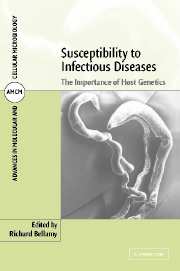Book contents
- Frontmatter
- Contents
- Contributors
- 1 Introduction
- 2 Application of genetic epidemiology to dissecting host susceptibility/resistance to infection illustrated with the study of common mycobacterial infections
- 3 The diverse genetic basis of immunodeficiencies
- 4 Genetic diversity in the major histocompatibility complex and the immune response to infectious diseases
- 5 The cystic fibrosis transmembrane conductance regulator
- 6 The influence of inherited traits on malaria infection
- 7 Polymorphic chemokine receptor and ligand genes in HIV infection
- 8 NRAMP 1 and resistance to intracellular pathogens
- 9 The interleukin-12/interferon-γ loop is required for protective immunity to experimental and natural infections by Mycobacterium
- 10 Mannose-binding lectin deficiency and susceptibility to infectious disease
- 11 Blood group phenotypes and infectious diseases
- 12 Genetics of human susceptibility to infection and hepatic disease caused by schistosomes
- 13 Genetic susceptibility to prion diseases
- Index
- Plate section
2 - Application of genetic epidemiology to dissecting host susceptibility/resistance to infection illustrated with the study of common mycobacterial infections
Published online by Cambridge University Press: 14 August 2009
- Frontmatter
- Contents
- Contributors
- 1 Introduction
- 2 Application of genetic epidemiology to dissecting host susceptibility/resistance to infection illustrated with the study of common mycobacterial infections
- 3 The diverse genetic basis of immunodeficiencies
- 4 Genetic diversity in the major histocompatibility complex and the immune response to infectious diseases
- 5 The cystic fibrosis transmembrane conductance regulator
- 6 The influence of inherited traits on malaria infection
- 7 Polymorphic chemokine receptor and ligand genes in HIV infection
- 8 NRAMP 1 and resistance to intracellular pathogens
- 9 The interleukin-12/interferon-γ loop is required for protective immunity to experimental and natural infections by Mycobacterium
- 10 Mannose-binding lectin deficiency and susceptibility to infectious disease
- 11 Blood group phenotypes and infectious diseases
- 12 Genetics of human susceptibility to infection and hepatic disease caused by schistosomes
- 13 Genetic susceptibility to prion diseases
- Index
- Plate section
Summary
INTRODUCTION
In the general context of genetic dissection of complex traits, genetics of human infectious diseases present the following several advantages and specificities: (1) there is a known causative agent which is absolutely required to become infected and to get the disease, but generally not sufficient stressing the importance of the host background; (2) environmental factors influencing the risk of infection are generally known and can be taken into account in the analysis when they are accurately measured; (3) there is a strong orientation in the choice of candidate genes based on the function of the gene and its known role in the response to the studied pathogen and/or on mouse–human chromosome homology exploiting the identification of murine resistance loci; and (4) the identification of major genes involved in the response to a given infectious pathogen takes advantage of the opportunity to study several complementary traits related to this pathogen. Among these traits are clinical phenotypes which are usually binary (affected/unaffected) but can take into account time to onset of the disease (e.g., time of progression to AIDS for HIV-infected patients), biological phenotypes measuring infection which can be either quantitative (e.g., infection intensities measured by fecal egg counts in schistosomiasis) or binary (HIV seropositive/seronegative), and immunological phenotypes measuring the immune response (antibody or cytokine levels, skin test response, etc.) more or less specific to a given antigen.
- Type
- Chapter
- Information
- Susceptibility to Infectious DiseasesThe Importance of Host Genetics, pp. 7 - 44Publisher: Cambridge University PressPrint publication year: 2003
- 1
- Cited by



